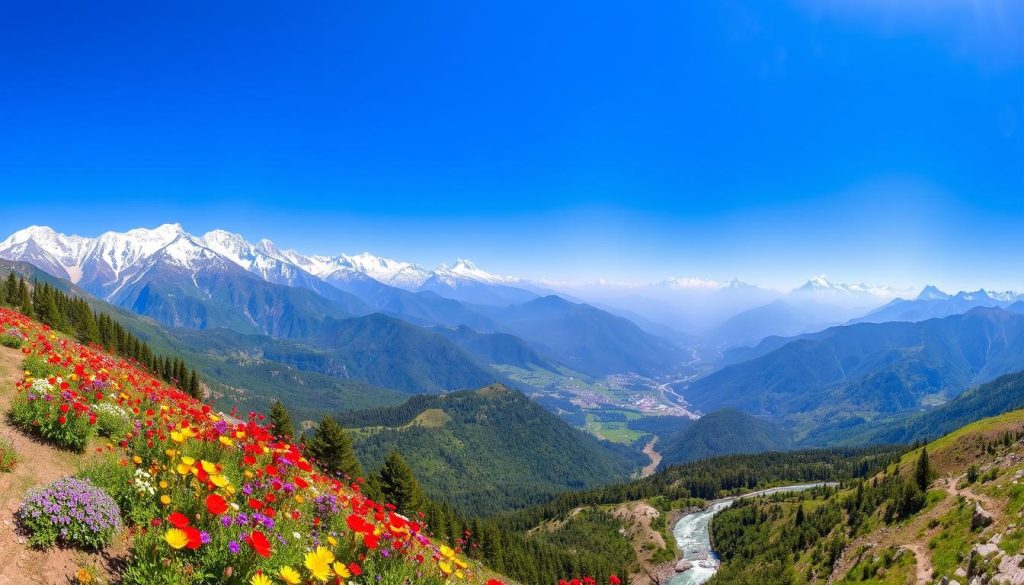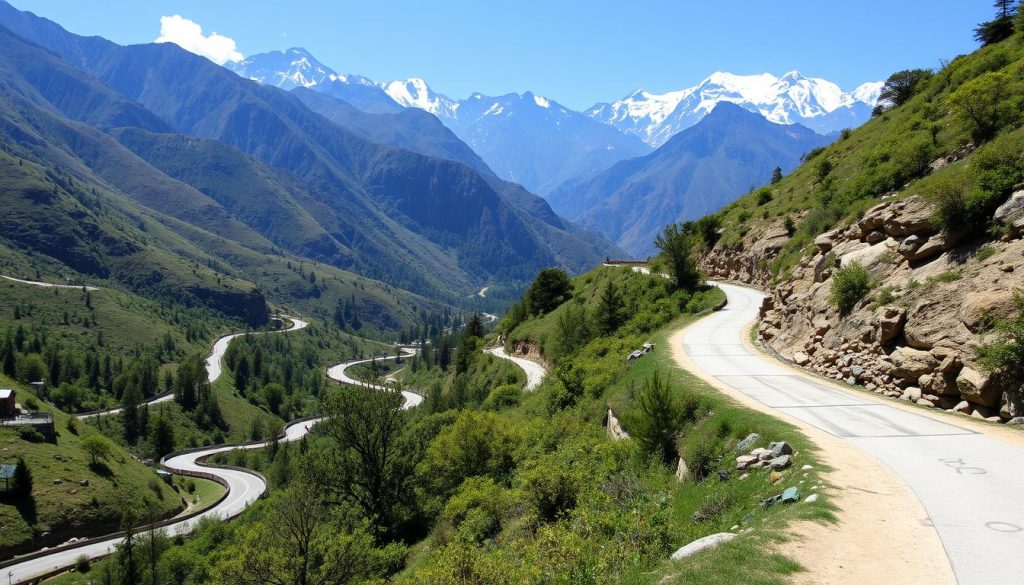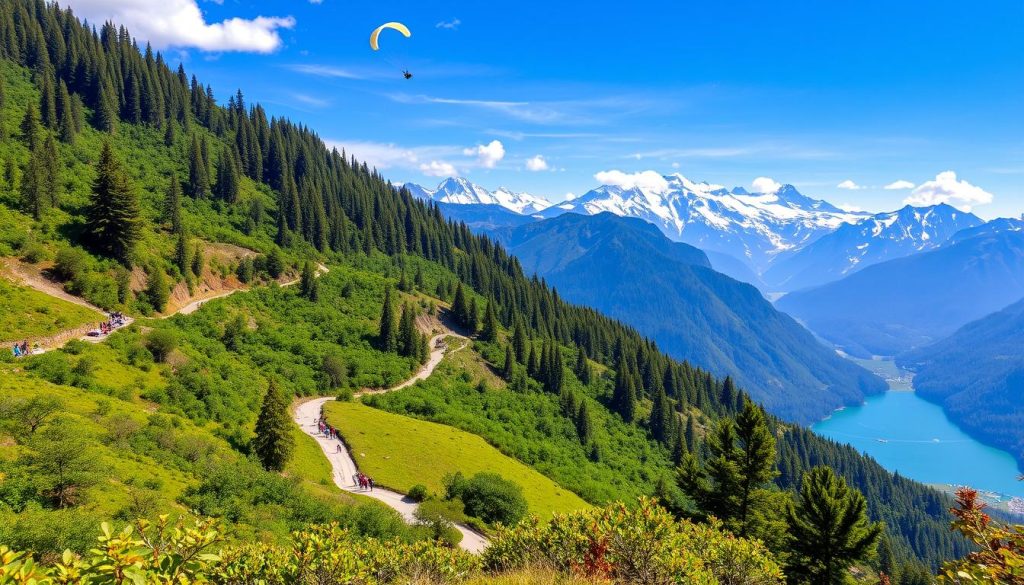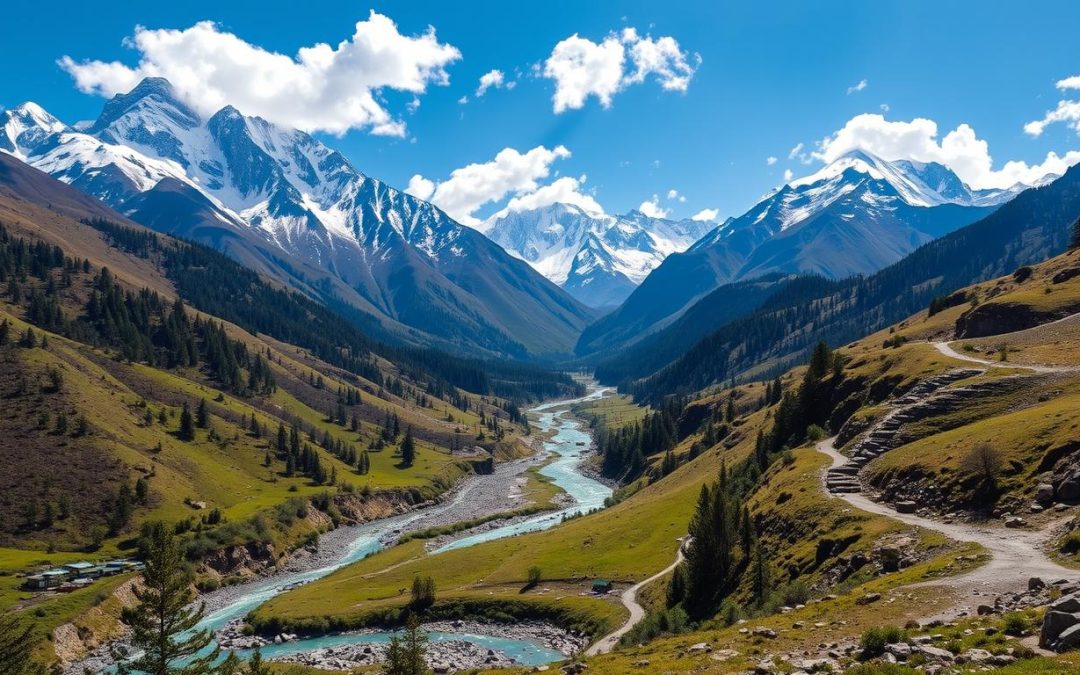Are you ready to explore a wilderness full of adventure and untouched beauty? The Great Himalayan National Park in Himachal Pradesh has secrets that can change your travel forever.
The park is in the Western Himalayas and is a UNESCO World Heritage Site. It offers amazing experiences for those who love nature and adventure. Near Kullu and Manali, it has stunning landscapes of snow, clear rivers, and diverse wildlife.
Your trip here will be filled with trekking, spotting wildlife, and enjoying Himachal Pradesh’s beauty. Whether you’re an experienced adventurer or new to nature, the Great Himalayan National Park has something special for you.
Key Takeaways
- UNESCO World Heritage Site with unparalleled natural beauty
- Located in the Western Himalayas near Kullu and Manali
- Offers diverse adventure activities and wildlife experiences
- Perfect destination for trekking, nature walks, and photography
- Unique ecosystem representing Himalayan biodiversity
Introducing the UNESCO World Heritage Site: GHNP Overview
The Great Himalayan National Park (GHNP) is in the Western Himalayas. It’s a stunning conservation area that shows the beauty of untouched nature. This UNESCO World Heritage Site covers 1,171 square kilometers, offering unmatched natural beauty and ecological importance.

The park is a key biodiversity hotspot with elevations from 1,500 to 6,000 meters. Its remote spot and little human touch have kept an amazing ecosystem alive. This ecosystem is home to a wide variety of life.
Location and Geographic Significance
GHNP is in the Kullu region of Himachal Pradesh. It has a rugged terrain and untouched wilderness. Key features include:
- Altitude range from 1,500 to 6,000 meters
- Diverse topographical zones
- Unique alpine and sub-alpine ecosystems
- Rakhundi top at 3,700 meters providing panoramic views
Conservation Area and Biodiversity
The park is full of biodiversity, protecting many plants and animals. Its ecological value is shown by:
- Over 1,000 flowering plant species
- 31 mammal species
- More than 200 bird species
- Four globally threatened mammal species
- Three globally threatened bird species
“The Great Himalayan National Park represents nature’s most intricate and delicate tapestry of life.” – Wildlife Conservation Expert
Historical Background and Recognition
GHNP was a Protected Area since 1984 and a national park since 1999. It was named a UNESCO World Heritage Site in 2014. This honor shows its global importance in conservation and ecological preservation.
Best Seasons to Visit GHNP: Weather and Planning Guide
Planning your trip to the Great Himalayan National Park needs careful thought about the seasons. The best times to visit are in spring and autumn.

- Spring Season: April, May, June
- Moderate temperatures
- Blooming wildflowers
- Perfect for wildlife photography
- Autumn Season: October, November
- Clear skies
- Crisp mountain air
- Excellent visibility for trekking
Planning tips suggest avoiding some periods:
- Monsoon Months (July-August): High risk of landslides and slippery trails
- Winter Months (December-March): Heavy snowfall restricts park access
“The mountains whisper their secrets during the perfect season – choose wisely!” – Local Himalayan Guide
| Season | Temperature Range | Best Activities |
|---|---|---|
| Spring | 10°C to 25°C | Wildlife Spotting, Photography |
| Autumn | 5°C to 20°C | Trekking, Bird Watching |
Remember to pack layers, waterproof gear, and prepare for quick weather changes when visiting this magnificent national park.
Getting to Great Himalayan National Park: Transportation Options
Planning your trip to the Great Himalayan National Park is exciting. You’ll need to think about how to get there. The park is in a remote area of Himachal Pradesh, perfect for adventurers.
Reaching the Park’s Gateway
Your journey starts in the Kullu-Manali region. The park is just an hour from the main highway. This makes it easy for travelers to reach.
By Air: Nearest Airports
The best airports for getting to GHNP are:
- Bhuntar Airport (Kullu) – the closest, about 50 kilometers away
- Chandigarh International Airport – great for those coming from far
- Indira Gandhi International Airport in Delhi – for international and domestic flights
By Road: Bus and Taxi Services
There are many ways to get to the park:
- Volvo buses run from Delhi and Chandigarh to Kullu and Manali
- They drop you off at Aut town, just after the tunnel
- Taxis from Aut to Gushaini are available for park treks
Pro Tip: Tell your bus conductor you need to get off at Aut town for a smooth trip.
Local Transportation Within the Park
Getting around GHNP is a bit tricky. Gushaini is the main entry point at 1,500 meters. From there, you can trek to Rolla, a 9-kilometer walk to 2,100 meters.

Your journey to the Great Himalayan National Park is as thrilling as the park itself. Get ready for breathtaking Himalayan views that will challenge and inspire you.
Trekking Adventures in GHNP’s Wilderness
Explore the Great Himalayan National Park (GHNP) for an unforgettable trekking adventure. This stunning area offers hiking trails that are unmatched in the Himalayas. With 754 square kilometers to explore, it’s a paradise for those who love the outdoors.
GHNP has trails for everyone, from easy day hikes to tough multi-day treks. No matter your skill level, you’ll find a path that suits you. Whether you’re new to trekking or have years of experience, there’s something for you.
- Short 2-day treks: Perfect for beginners, offering a gentle introduction to the park’s wilderness
- Extended 9-day expeditions: Deep wilderness exploration reaching remote river sources
- Elevation ranges from 1500m to 2100m, providing varied terrain challenges
“The trek from Tirthan Valley to Rolla covers 9 km, beginning at 1500m and ascending to 2100m, presenting a remarkable hiking experience.” – Local Trekking Guide
Some treks, like the 8 km route from Kharongcha to Shilt Thach, are tough but rewarding. You’ll see amazing landscapes and wildlife, including 215 bird species and rare snow leopards.
Here are some trekking tips for GHNP:
- Prepare for varying temperatures and terrain
- Carry adequate water and use fresh mountain springs
- Respect wildlife and follow conservation guidelines
- Budget approximately Rs 2500 per day per person
Trekking in GHNP is more than just a physical challenge. It’s a chance to connect deeply with nature in one of the Himalayas’ most untouched places.
Great Himalayan National Park, Himachal Pradesh: Best Things to Do – Top Picks
Discover the ultimate adventure playground in the heart of the Himalayas. The Great Himalayan National Park offers an unparalleled experience. It combines breathtaking landscapes with thrilling activities that will challenge and inspire you.
Multi-day Trek Experiences
Embark on unforgettable multi-day treks through the park’s stunning wilderness. The park has a range of trekking trails for all skill levels. Hikers can explore diverse terrain, including:
- Alpine meadows with panoramic mountain views
- Dense forest trails teeming with unique flora
- Remote valleys with pristine landscapes
Wildlife Spotting Opportunities
Wildlife spotting in the Great Himalayan National Park is a dream come true for nature lovers. The park hosts an incredible diversity of fauna, including rare and endangered species. Key wildlife viewing highlights include:
- Himalayan Tahr
- Snow Leopard
- Musk Deer
- Numerous bird species
Adventure Activities and Sports
Get your adrenaline pumping with an array of adventure activities. The park offers an exciting range of sports for thrill-seekers:
- Rappelling on steep mountain faces
- Rock climbing with varying difficulty levels
- River crossing challenges
- Trout fishing in mountain streams

Whether you’re an experienced adventurer or a nature enthusiast, the Great Himalayan National Park promises an immersive experience. It combines multi-day treks, incredible wildlife spotting, and heart-pumping adventure activities in one of the most beautiful landscapes on earth.
Wildlife and Biodiversity Exploration
The Great Himalayan National Park is a true gem for wildlife lovers. It’s located in Himachal Pradesh and is a UNESCO World Heritage Site. This park covers 754 square kilometers of untouched nature.
Exploring this park, you’ll see many animals that live here. It’s home to 375 animal species. This makes it a living museum of Himalayan wildlife.
- Home to 375 fauna species including mammals, birds, reptiles
- Contains 832 identified plant species from 128 different families
- Hosts the largest known population of western tragopans
- Provides sanctuary to rare species like Red Pandas
“The Great Himalayan National Park is not just a protected area, but a critical sanctuary for some of the world’s most unique wildlife.” – Wildlife Conservation Expert
Visitors can see amazing wildlife here. The park has forests and meadows, perfect for many animals. You might see a Himalayan black bear or a snow leopard.
| Species Category | Number of Species |
|---|---|
| Mammals | 75 |
| Birds | 209 |
| Reptiles | 17 |
| Insects | 74 |
By visiting, you help protect this amazing place. Your visit supports conservation and helps keep these ecosystems safe.
Cultural Immersion in the Ecozone Villages
Explore the essence of Himalayan heritage in the ecozone villages around the Great Himalayan National Park. These remote areas offer a glimpse into a traditional way of life that has stayed the same for many years.
Traditional Lifestyle and Customs
The people living in these ecozone villages show us what sustainable mountain living is all about. Their lives are centered around farming, strong community ties, and a deep respect for nature.
- Generations-old farming practices
- Handcrafted textiles and tools
- Community-centered social structures
- Preservation of indigenous knowledge
Local Cuisine and Agriculture
Exploring the local food scene in these villages is a journey into a rich agricultural past. Farmers here grow a wide variety of crops that feed their communities.
| Crop Type | Local Significance | Market Value |
|---|---|---|
| Wheat | Staple food | Local consumption |
| Corn | Traditional crop | Local and regional markets |
| Apples | Cash crop | National export |
| Apricots | Regional specialty | High market demand |
Community-Based Tourism
Join local communities through responsible tourism that supports their traditional ways of life. These experiences help the economy while keeping cultural heritage alive.
“Our visitors become part of our story, not just observers.” – Local Village Elder
By taking part in community-based tourism, you help keep the balance between preserving culture and supporting the economy in these unique Himalayan ecozone villages.
Sustainable Tourism and Conservation Efforts
The Great Himalayan National Park is a leading example of sustainable tourism and conservation. It’s a UNESCO World Heritage Site. The park uses new ways to protect its ecosystem and help local communities through eco-tourism.
Local efforts aim to give villagers new ways to make money. They used to rely on the forest. The park’s plan includes:
- Community-based tourism programs
- Training in sustainable livelihood options
- Engaging local residents in conservation activities
“Conservation is not just about protecting nature, but about supporting the people who live closest to it.” – Local Conservation Expert
The Eco-development Project Area is 5 kilometers around the park. It has 120 small villages. These communities are key in keeping the park’s biodiversity safe and supporting sustainable tourism.
| Conservation Aspect | Impact |
|---|---|
| Local Community Involvement | Direct participation in park management |
| Alternative Income Sources | Reduced dependency on forest resources |
| Eco-tourism Initiatives | Sustainable economic development |
Visitors can help by choosing eco-friendly travel. Himalayan Ecotourism helps create programs that protect the environment. These programs also offer unique experiences for those who want to travel sustainably.
The park shows how conservation and community growth can go together. It’s a model for sustainable tourism that helps both the environment and local people.
Conclusion
Your trip to the Great Himalayan National Park is more than a vacation. It’s a chance to connect with nature in a special way. This UNESCO World Heritage Site is a top spot for eco-tourism, offering breathtaking views and adventures.
Exploring the park, you’ll see ancient forests and rare animals. You’ll also learn about the local mountain communities. The park’s 620 square kilometers are full of wonders, waiting for you to discover them.
Your visit can help protect this amazing place. By traveling responsibly, you support conservation. Trekking, wildlife watching, or visiting villages, your journey helps preserve this natural gem.
Get ready for an adventure in this Himalayan paradise. It’s not just a trip; it’s a life-changing experience. Bring your sense of adventure, respect for nature, and a commitment to travel responsibly. Prepare for an unforgettable journey in the Great Himalayan National Park.
The above is subject to change.
Check back often to TRAVEL.COM for the latest travel tips and deals.
